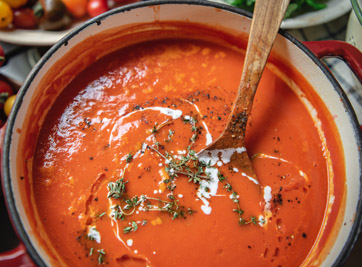
Identifiers
INS No. 160d(i); Lycopene (synthetic)
INS No. 160d(ii); Lycopene extract from tomato
INS No. 160d(iii); Lycopene from blakeslea trispora
Tomato lycopene extract; tomato lycopene concentrate
E 160d(i); Synthetic lycopene
E 160d(ii); Lycopene from red tomatoes
E 160d(iii); Lycopene from Blakeslea trispora
Physical Description
Lycopene is a naturally occurring pigment found in vegetables (especially tomatoes), fruits, algae and fungi. It can also be synthesized chemically. Lycopene, Synthetic occurs as a dark red to dark violet crystals or crystalline powder and is an open-chain, unsaturated C40 carotenoids made up of eight isoprene units, and consists of a mixture of geometric isomers. Lycopene Extract from Tomato occurs as a dark-red viscous liquid and is obtained through ethyl acetate extraction of the pulp of ripe red tomatoes (Lycopersicon esculentum L.) followed by removal of the solvent. Lycopene from Blakeslea trispora occurs as a red crystalline powder and is a fermentation product that accumulates inside the biomass of the fungus and is extracted and purified using suitable solvents.
Common Uses
Lycopene extract from tomato is used in food including dairy products, non-alcoholic flavored drinks, cereal and cereal products, bread and baked goods and spreads, providing color shades from yellow to red. Lycopenes may also be found to provide color to yogurts, candies, soups, salad dressings, sauces, fruit and vegetable juices.
Specifications
JECFA
Commission Regulation (EU) No 231/2012
Codex GSFA Provisions
Lycopene synthetic, Lycopene tomato, and Lycopene Blakeslea trispora (INS Nos. 160d(i-iii)) are food additives that are included in Table 3 of the Codex General Standard for Food Additives (GSFA), and as such may be used in specified foods under the conditions of good manufacturing practices (GMP) as outlined in the Preamble of the Codex GSFA.
Regulatory Approvals
Safety Reviews
Safety evaluation of certain food additives and contaminants (Sixty-seventh report of the Joint FAO/WHO Expert Committee on Food Additives) WHO Food Additives series no. 58, 2007. Available online
Safety evaluation of certain food additives (Seventy-first meeting of the Joint FAO/WHO Expert Committee on Food Additives) WHO food additives series No. 62, 2010. Available online
Listing of Color Additives Exempt from Certification; Tomato Lycopene Extract and Tomato Lycopene Concentrate, 70 FR 43043 (July 26, 2005). Available online
Scientific Opinion of the Panel on Food Additives, Flavorings, Processing Aids and Materials in Contact with Food on a request from the Commission on the safety in use of lycopene as a food color. The EFSA Journal (2008) 674, 1-12. Available online